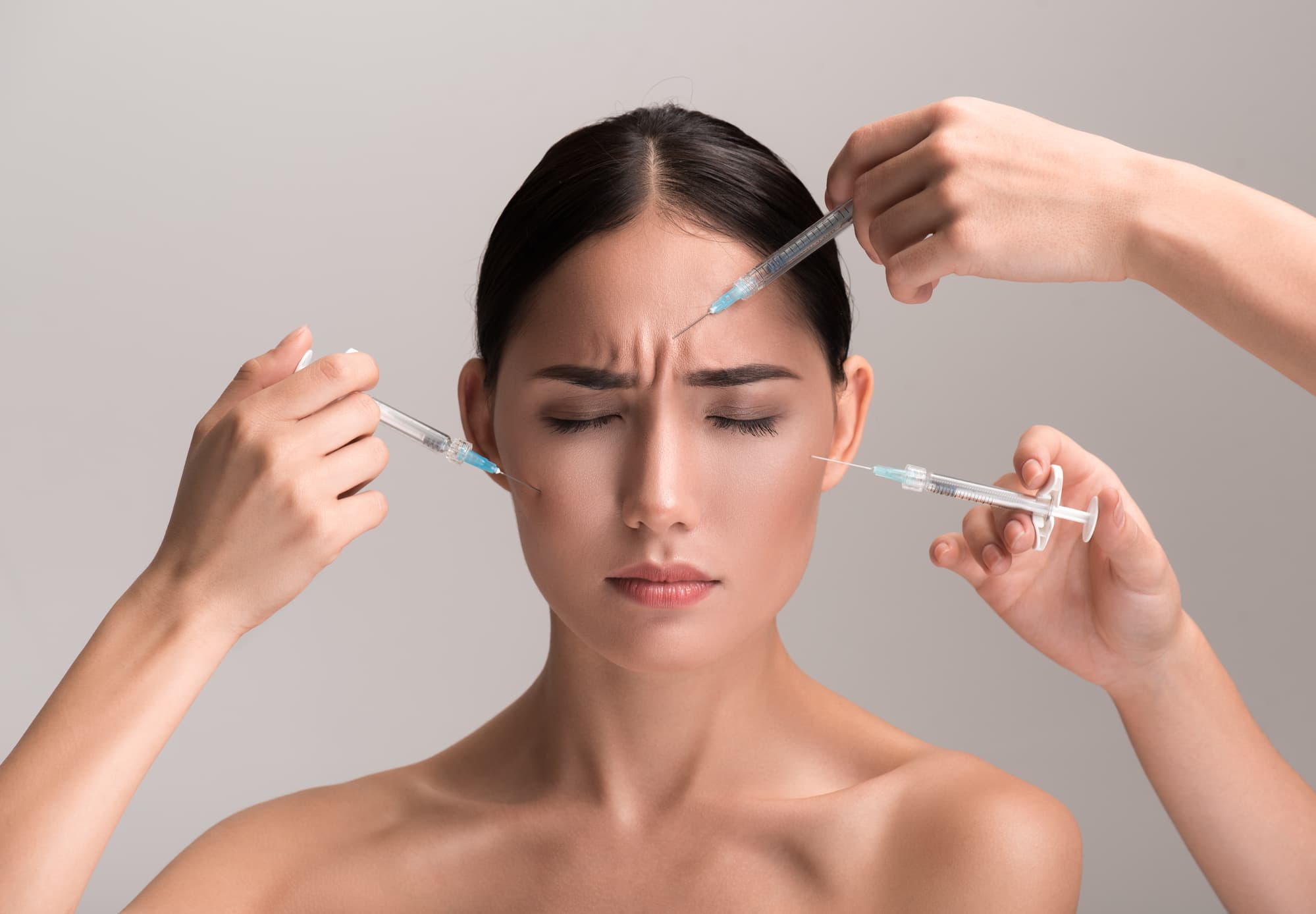
Frown lines are a common cosmetic concern caused by repetitive muscle contractions in the forehead and glabella region, commonly treated with botulinum toxin (Botox). The FDA approved the treatment of glabellar lines with the BoNT in 2002. However, before injecting Botox between the eyebrows, a profound understanding of facial anatomy is indispensable in achieving the desired results while ensuring patient safety.
The Facial Muscles that Create Frown Lines
Glabellar lines, or frown lines, are the vertical creases that form between the eyebrows and are primarily a result of the repetitive contraction of specific facial muscles, namely the corrugator supercilii and the procerus.
The corrugator supercilii muscle is a paired muscle located beneath the frontalis muscle, and its primary function is to draw the eyebrows medially and downward, causing a furrow between them. This muscle plays a central role in forming vertical frown lines.
The procerus muscle is a thin, triangular muscle situated just below the skin between the eyebrows and above the bridge of the nose. Contraction of the procerus muscle pulls the skin of the forehead downward, contributing to the appearance of frown lines.
The dynamics of the corrugator supercilii and procerus muscles, often as a response to emotional expressions or even habitual frowning, form these undesirable creases.
However, in the 2021 study, “Anatomical Injection Guidelines for Glabellar Frown Lines Based on Ultrasonographic Evaluation,” the authors used ultrasound to identify two distinct types of glabellar frowning, which they classified as Type A and Type B. They concluded that Type A frowning was more common and was caused by the contraction of the corrugator supercilii and procerus muscles. Type B frowning was less common and caused by frontalis muscle contraction.
Botox for Glabellar Lines Treatment: Mechanism of Action
Botox works by inhibiting the release of acetylcholine, a neurotransmitter responsible for muscle contractions. When acetylcholine release is blocked, muscle activity is temporarily paralyzed, preventing further skin wrinkling.
With its precisely targeted mechanism of action, Botox effectively addresses frown lines by modulating the activity of the corrugator supercilii and procerus muscles.
By injecting a neurotoxin into the corrugator supercilii, procerus muscle, or frontalis muscle, healthcare professionals can reduce the muscle’s ability to contract forcefully, resulting in the softening of frown lines and a more youthful appearance.
Nefer Fallico and Nicolò Scuderi from the Sapienza University of Rome and Marco Mazzocchi from Università degli Studi di Perugia in 2023 conducted a study to evaluate the efficacy and safety of Botox injections for glabellar frown lines in Italian patients. The article found that Botox injections effectively reduced the severity of frown lines and were well-tolerated by patients.
The longevity of Botox’s effects varies among individuals, but the results generally last three to six months. Consequently, patients may require periodic follow-up treatments to maintain their desired results.
Injection Techniques for Frown Lines Botox
Prior to treatment, healthcare professionals should assess the patient’s medical history, including any allergies or previous adverse reactions to Botox. Patients should be informed that botulinum toxin will soften, but not entirely eliminate, frown lines, as maintaining some natural facial expression is desired.
Ultrasound-based evaluation can provide valuable information into the movement of facial muscles, which is essential in the clinical application of Botox for the forehead. In addition, ultrasound can also be used to visualize the underlying anatomy of the face. This information is crucial for optimizing the effectiveness of the treatment, as it allows doctors to target specific muscles and avoid injecting the drug into areas that could be injured.
While Botox procedures for frown lines are generally safe, it is crucial to be aware of potential adverse effects and strategies for their prevention. Complications resulting from improper injection technique may include:
- Asymmetry;
- Unintended muscle weakness;
- Eyelid ptosis;
- Toxin migration to adjacent areas.
The efficacy and safety of Botox treatments for frown lines are intricately tied to the precision of the injection technique and an understanding of the anatomical landmarks.
Precision is critical when administering Botox between the eyes. Even minor deviations from the intended injection site can yield suboptimal results or undesirable side effects.
The anatomical implications of injecting Botox in the glabellar area have been studied by several researchers. In a study published in “Toxins” journal (2022), Hee-Jin Kim and Kyu-Ho Yi from Yonsei University Seoul, Seoul, South Korea, presented an anatomical proposal for Botox injection for glabellar frown lines. The authors found that the most effective injection sites for the corrugator supercilii muscle (CSM) were between the eyebrows and at the level of the supraorbital notch. They also found that the best injection site for the procerus muscle is at the level of the nasofrontal angle.
The paper “Anatomical Injection Guidelines for Glabellar Frown Lines Based on Ultrasonographic Evaluation” also found that the most effective injection sites for Botox in Type A frowning were between the eyebrows and at the level of the supraorbital notch. For Type B frowning, the most effective injection sites were at the level of the nasofrontal angle.
Healthcare professionals learn the specific anatomical spots that define the target areas for injection to minimize the risk of complications after forehead lines Botox.
The injections are made with a fine needle, and the amount of Botox injected varies depending on the patient.
After the glabellar lines Botox procedure, patients should receive clear post-care instructions, including avoiding strenuous physical activity, refraining from lying down for several hours post-injection, and refraining from touching or massaging the treated area.
Scheduled follow-up appointments allow healthcare professionals to monitor the progress of the treatment and address any concerns or questions patients raise.
Conclusion
In summary, the administration of Botox for forehead lines demands a profound understanding of facial anatomy, precise injection techniques, and thorough patient assessment.
By integrating international best practices and staying informed about the latest developments in the field, doctors can deliver safe, effective, and satisfying patient outcomes.
FAQ
What complications can arise when injecting the frontalis?
Injecting Botox into the frontalis muscle can be effective in reducing the appearance of forehead wrinkles and horizontal lines, but there are potential complications associated with this procedure, which can include the following:
- Eyebrow asymmetry. Injecting Botox in forehead lines can cause uneven weakening, leading to one eyebrow appearing higher or lower than the other. This can result in a lopsided or unnatural appearance and may require additional treatment to correct.
- Eyelid ptosis. Botox can migrate to nearby muscles, affecting the levator palpebrae superioris muscle, which lifts the upper eyelids. When this muscle is impacted, it can result in drooping of the upper eyelid.
- Brow drop. Injecting Botox too low on the forehead or using an excessive dosage can lead to an unwanted brow drop that can cause a heavy, hooded appearance of the eyebrows and eyes, which can be aesthetically displeasing to patients.
- Migration to adjacent muscles. Botox can sometimes diffuse or migrate to nearby muscles, affecting areas unintended for treatment, resulting in unintended changes in facial expressions or complications in adjacent areas.
- Frozen facial expressions. Over-treating the frontalis muscle can lead to a rigid or unnatural appearance, where the patient has limited movement in the forehead and eyebrows, which can be a significant concern for some patients.
On the flip side, under-treatment of the frontalis muscle may result in inadequate wrinkle reduction, leaving the patient dissatisfied with the results.
To minimize the risk of complications when injecting Botox between eyebrows in the frontalis muscle, doctors must thoroughly assess the patient’s facial anatomy, customize the treatment plan to their unique needs, use precise injection techniques, and follow appropriate dosage guidelines.
In most cases, complications associated with Botox injections into the frontalis can be managed and, if necessary, corrected with follow-up treatments or adjustments.
What are the side effects of Botox frown lines?
When administrated by qualified healthcare professionals, injecting Botox in frown lines is generally considered a safe and effective cosmetic procedure. However, like any medical treatment, it can have potential side effects and risks that may include:
- Temporary bruising;
- Mild pain, tenderness, or discomfort at the injection site;
- Swelling;
- Headache;
- Eyelid drooping (ptosis) typically resolves on its own as the effects of Botox wear off but may require additional treatments in the interim.
- Asymmetry;
- Allergic reactions to Botox with symptoms like itching, rash, dizziness, or difficulty breathing;
- Flu-like symptoms, such as fatigue or muscle weakness, although these symptoms are uncommon and typically resolve quickly.
- Botox injections for frown lines are precise, but there is a small risk of affecting nearby facial muscles, leading to unintended changes in facial expressions.
Doctors must inform their patients to promptly report any unusual or severe side effects to their healthcare provider. While most adverse reactions associated with Botox frown line treatment are mild and temporary, careful monitoring and appropriate management can ensure a positive and safe patient experience.
References
Yi KH, Lee JH, Hu H, Kim HJ. Anatomical proposal for botulinum neurotoxin injection for glabellar frown lines. Toxins. 2022;14(4):268. doi:10.3390/toxins14040268.
Dessy LA, Fallico N, Mazzocchi M, Scuderi N. Botulinum toxin for glabellar lines. American Journal of Clinical Dermatology. August 2011:1. doi:10.2165/11592100-000000000-00000.
Yi KH, Lee JH, Hu H, Kim HJ. Novel anatomical guidelines on botulinum neurotoxin injection for wrinkles in the nose region. Toxins. 2022;14(5):342. doi:10.3390/toxins14050342.
Kim SB, Kim HM, Ahn H, et al. Anatomical Injection Guidelines for Glabellar Frown Lines Based on Ultrasonographic Evaluation. Toxins (Basel). 2021;14(1):17. Published 2021 Dec 25. doi:10.3390/toxins14010017.
De Boulle K., Fagien S., Sommer B., Glogau R. Treating glabellar lines with botulinum toxin type A-hemagglutinin complex: A review of the science, the clinical data, and patient satisfaction. Clin. Intervig. Aging. 2010;5:101–118. doi: 10.2147/CIA.S9338.
Injectable aesthetics are popular due to their ability to provide noticeable results with minimal downtime compared to surgical procedures. They are versatile and can be tailored to meet individual aesthetic goals, whether it's enhancing lips, restoring facial volume, or smoothing out wrinkles. However, they should always be administered by qualified professionals to ensure safety and achieve optimal results.
Injectable aesthetics are used to enhance facial features, reduce the signs of aging, and improve overall facial symmetry and appearance.
Key types of injectable aesthetics include:
-
Dermal Fillers: These injectables are used to add volume, fill in wrinkles and folds, and enhance facial contours. They often contain substances like hyaluronic acid, collagen, or calcium hydroxylapatite, which help plump up the skin and smooth out fine lines and wrinkles.
-
Botulinum Toxin (Botox): Botulinum toxin injections temporarily relax facial muscles that cause wrinkles and lines to form. It is commonly used to treat forehead lines, frown lines between the eyebrows, and crow's feet around the eyes.
-
Collagen Stimulators: These injectables stimulate the body's own collagen production, helping to improve skin texture and firmness over time. Examples include poly-L-lactic acid (Sculptra) and calcium hydroxylapatite (Radiesse).
-
Neurotoxin Injections: Besides Botox, other neurotoxins such as Dysport and Xeomin are used similarly to reduce wrinkles and lines.





